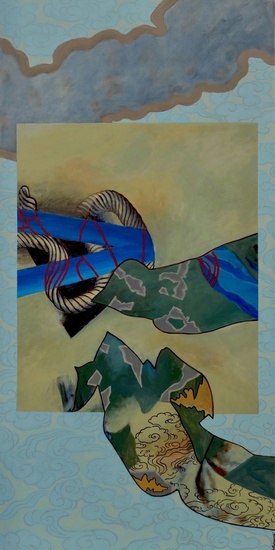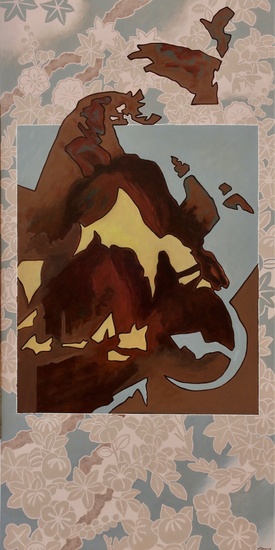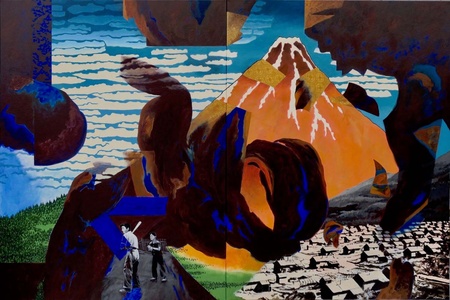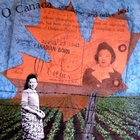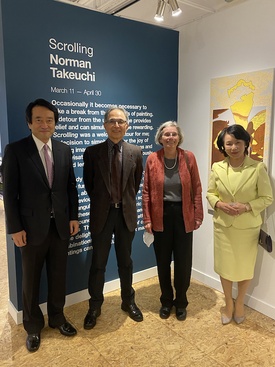
Even in the midst of a global pandemic, restrictions have not slowed down Ottawa Nisei artist Norman Takeuchi who recently launched his second exhibition in two years: Equal Time and this one entitled Scrolling.
Takeuchi’s father Nawoki was from Kochi and mother, Miyoko, was born in Vancouver. During World War Two the family stayed in the small Okanagan community of Westwold, BC along with some other Japanese Canadian families. After the war, they returned to Vancouver where his father reestablished his gardening business and mom set up a dress-making shop.
Born in Vancouver, Takeuchi, recalling his nascent interest in art, said:
“I was always interested in drawing. In high school, I had decided I wanted to become an architect but after graduation, dad insisted I work with him for one year before going to university. Of course I resented that but I had no choice. In retrospect though, it was the best thing he could have done for me.
“During that period, I enrolled at the Vancouver School of Art (VSA) to take some night courses (I can’t even remember what) and knew immediately that was where I belonged. When my year of gardening was up, I enrolled at the VSA and scrapped the idea of becoming an architect. That’s how my art career started and I have my dad to thank. Takeuchi graduated from the Vancouver School of Art in 1962.
“I went to London, England in 1962 with the help of a Leon and Thea Koerner Grant with the sole purpose of setting up a studio and producing work. I also wanted to get as much exposure as possible to art in another country and hopefully learn in the process. And I did learn. I actually had a solo show before I returned to Canada. My very first one!
“I went back to London in 1967 with a Canada Council grant for exactly the same purpose. By then, I was married so Marion and I went together and we spent a memorable year there. Again, I had produced enough work for a show but this time, no luck. We packed up all the canvases and returned to Ottawa where I was able to show my work.”
Takeuchi left his career as a designer in 1996 when he decided to focus on art.
Takeuchi has two younger brothers: Ken (Vancouver, BC) and Bob (Surrey, BC).
This is your second exhibition (Equal Time, November 2020) during the pandemic. Lockdowns certainly haven't slowed you down! Has this been a particularly prolific time for you?
Marion and I have always been homebodies so when the pandemic hit, it was easy to stay home and carry on as usual except that, not having to meet outside obligations, I now had more time to spend in the studio and I made the most of it.
Why scrolls?
For over a year I had been working on a different series titled Long Division for a solo show to be exhibited this coming September. The work makes reference to both the history of the Japanese Canadians and that of my family. It got pretty draining so that’s when I decided to take a break and turn to lighter, less challenging work.
As I was wondering what to do, I happened to see some images of Japanese scrolls and I guess they must have triggered something in my brain because I visualized paintings based on the scroll format. The first one was sort of an experiment but it turned out well so a new series was born.
Can you please describe the medium that you worked with for these works? Did you take any particular inspiration from traditional Japanese-style scrolls? Any particular artists or works?
The medium is acrylic paint on canvas. As I mentioned, seeing images of Japanese scroll paintings, or kakemono, started me thinking that the scroll format could be the basis for a new series of work unlike anything I’ve done before. For starters, the canvas would be narrow, 2’ x 4’, a shape I have never used. As well, there would be only two main components in the composition, a rectangle in the centre and a decorative pattern filling the space around it.
My intention was not to accurately reproduce scrolls but rather to use them as a starting point from which I could create a new take on the JC theme.
Are there any particular thematic connections that you can point out between Equal Time and Scrolling?
Despite the fact that the works in these two exhibitions are very different, there are two thematic connections: the use, albeit in different ways, of Japanese images and the abstract forms. In Equal Time, the two were closely integrated while in Scrolling, they are clearly separated. The abstract forms in Scrolling are confined to the central rectangle and the Japanese reference is reduced to decorative designs around the rectangle. The decorative designs were based on reproductions in the many books I have on Japanese art and design.
Can you please talk about the ongoing use of “the camps” as a theme in your work? How are they represented in this exhibition? What kind of themes are you exploring in this show?
There are no references to camps because these paintings were meant to be a break from the demands of my previous work. Instead, the theme, if I can call it that, in Scrolling was to return to basics, to revisit the fundamentals of colour, shapes and composition and also to rediscover the joy of pure painting without overthinking the content.
Is it cathartic for you to use these Japanese symbols? How so?
Yes it is. By deliberately using Japanese imagery in my work, it is my attempt to cast out the unease I felt being Japanese and it became a declaration of knowing who I am.
In our 2020 interview, you spoke about the Japanese community’s struggle for equality in all aspects of Canadian life and by extension, today, a similar struggle by other ethnic minorities. How would you describe your activist’s voice?
Because by nature I am a reserved kind of person, I do not see myself as an activist. Even though I feel very strongly about the injustices committed against the Japanese Canadians and make references to that in my work, it’s all done in a low-key way. So low-keyed that many people will probably not catch the storyline. I accept that.
Have you come to any new understandings of yourself and your JC identity through the pandemic?
In the early stages of the pandemic when there were so many incidents of anti-Asian racism, I was a bit surprised, after coming home one day from our daily walk around the neighbourhood, to find myself thinking no one accosted me and told me to go back to where I came from. It made me realize I was still very aware of what I look like. It’s interesting that something that didn’t happen made me aware that I look different. On the other hand, I understood I was lucky to live in an area where people are open, decent and tolerant.
What do you make of the societal changes that have been happening like the truckers convoy in Ottawa? What about the war in Ukraine?
Although I’ve tried to keep informed through the news media about the truckers convoy, I still have no idea how it has affected our society. As for the war in Ukraine, I am as horrified and outraged as everyone else at the appalling death and destruction caused by the invasion. I’m also in awe of the incredible bravery of the Ukraine people but worry that unless there is some sort of miraculous intervention, this is a battle they cannot win. I’m hoping the miracle will happen.
*Check out Norman Takeuchi's Scrolling at Studio Sixty Six, contemporary art gallery until April 30, 2022.
© 2022 Norm Masaji Ibuki


